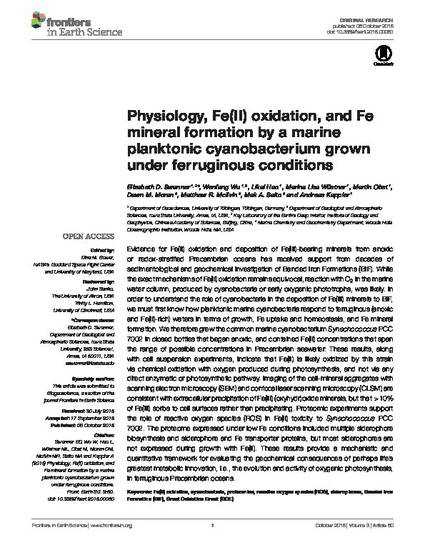
Evidence for Fe(II) oxidation and deposition of Fe(III)-bearing minerals from anoxic or redox-stratified Precambrian oceans has received support from decades of sedimentological and geochemical investigation of Banded Iron Formations (BIF). While the exact mechanisms of Fe(II) oxidation remains equivocal, reaction with O2 in the marine water column, produced by cyanobacteria or early oxygenic phototrophs, was likely. In order to understand the role of cyanobacteria in the deposition of Fe(III) minerals to BIF, we must first know how planktonic marine cyanobacteria respond to ferruginous (anoxic and Fe(II)-rich) waters in terms of growth, Fe uptake and homeostasis, and Fe mineral formation. We therefore grew the common marine cyanobacterium Synechococcus PCC 7002 in closed bottles that began anoxic, and contained Fe(II) concentrations that span the range of possible concentrations in Precambrian seawater. These results, along with cell suspension experiments, indicate that Fe(II) is likely oxidized by this strain via chemical oxidation with oxygen produced during photosynthesis, and not via any direct enzymatic or photosynthetic pathway. Imaging of the cell-mineral aggregates with scanning electron microscopy (SEM) and confocal laser scanning microscopy (CLSM) are consistent with extracellular precipitation of Fe(III) (oxyhydr)oxide minerals, but that >10% of Fe(III) sorbs to cell surfaces rather than precipitating. Proteomic experiments support the role of reactive oxygen species (ROS) in Fe(II) toxicity to Synechococcus PCC 7002. The proteome expressed under low Fe conditions included multiple siderophore biosynthesis and siderophore and Fe transporter proteins, but most siderophores are not expressed during growth with Fe(II). These results provide a mechanistic and quantitative framework for evaluating the geochemical consequences of perhaps life's greatest metabolic innovation, i.e., the evolution and activity of oxygenic photosynthesis, in ferruginous Precambrian oceans.
Available at: http://works.bepress.com/elizabeth_swanner/3/

This article is from Front. EarthSci.3:60. doi:10.3389/feart.2015.00060. Posted with permission.